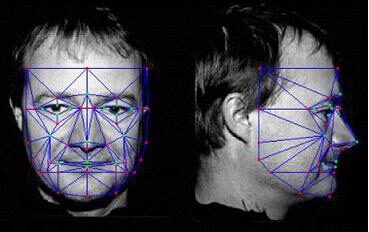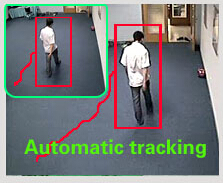Intelligent video analysis, English name: IVS (Intelligent Video System). Intelligent video analysis is the use of computer image visual analysis technology. With the help of powerful data processing functions of computer chips, high-speed video image analysis is performed, and the key information in the image is extracted, compared and analyzed by separating the background and objects in the scene. If the camera is likened to the human eye, then intelligent analysis is equivalent to putting this thinking brain on the eye.

Diagnostic Intelligence Analysis
Diagnostic intelligent analysis is mainly aimed at the common video faults such as snowflakes, scrolling, blurring, color cast, gain imbalance, pan/tilt loss, picture freeze, and other common video faults, video signal interference, video quality degradation, accurate analysis, judgment, and alarm. Diagnostic intelligent analysis technology is relatively simple to implement, usually in the form of a back-end management platform, and plays a significant role in the daily monitoring of large-scale monitoring projects, especially city-level monitoring. Currently, some DSP-based intelligent analysis devices, DVRs, and DVSs on the market come with this auxiliary function.

Identification Intelligence Analysis
The technology is biased towards the analysis and processing of static scenes. Through the core technologies such as image recognition, image matching, and pattern matching, the extraction and analysis of relevant features information such as people, vehicles, and objects can be realized.
The face (image) recognition and analysis technology is an emerging technology that has been rapidly developed in recent years. Feature face, facial key feature location extraction and 2D (or 3D) shape detection are some of its key technologies. The technology is mainly used in the early access control time and attendance system. With the development and maturity of technology, through the perfect combination with the restoration technology of portraits, the department has applied this technology to the detection of cases and has made remarkable achievements in major cases. With the emergence of technologies such as cloud computing and cloud analysis with massive video data mining capabilities, face recognition technology can achieve rapid real-time comparison with city-level portrait databases, and cloud-storage technology can be used to easily achieve portrait-to-city data sharing. This will be * Departments quickly find criminal suspects to provide strong technical support, but also will usher in a historic opportunity for rapid development of face recognition.
In the application of vehicle identification and analysis is mainly license plate recognition technology. After years of development and application, the technology has been very mature. The emergence of fuzzy license plate restoration and identification technology makes the technology no longer limited to high definition, and began to spread to the standard definition field. License plate recognition technology is widely used in parking lots entrances and exits, highway toll gates and other places. In recent years, it has developed rapidly. With the traffic electronic bayonet system, license plate recognition technology has been widely used to capture vehicle traffic violations, effectively reducing The number of vehicle traffic violations has greatly reduced the occurrence of traffic accidents.
The recognition of object types is still in the experimental stage. The main reasons are as follows: 1. The modeling, feature extraction and positioning, classification and screening of the objects in the scene are complicated and the calculation volume is large; 2. The variety of items is required. Matching database information is quite large. Therefore, at this stage, the identification of objects is still in the “fuzzy†detection phase, which means that only the object is identified as the object. However, what exactly is the object, the device can not be accurately identified, such as the legacy object detection function introduced by individual intelligent analysis vendors.
Behavioral intelligence analysis
This technology focuses on the analysis and processing of dynamic scenes. Typical functions include: vehicle retrograde and related traffic violation detection, zone intrusion detection, fence overturn detection, squall line crossing detection, item theft detection, occupancy management detection and passenger flow statistics. Motion Detection (VMD) is the "early intelligence" of intelligent analysis of this kind. VMD distinguishes according to the motion of pixel blocks in the video picture. The disadvantage is obvious: based on two-dimensional analysis, false positives are too high to recognize the movement. Whether the pixel block is an interference or a target, it is even more difficult to accurately determine its behavior. Most DVRs or DVS devices on the market today come with VMD functionality. Some intelligent analysis manufacturers have made improvements and innovations in the subsequent algorithms. Some are PC-based video analysis software, while others are DSP-based video analysis. It is worth mentioning here is the more advanced three-dimensional visual analysis technology.

As the name implies, 3D visual analysis technology is a video analysis algorithm based on 3D scenes. It is called "visual analysis" because it really has the ability to conduct video analysis from the behavior. When the 3D vision analysis technology adapts to the scene for the first time, there will be a 3D modeling process of human-computer interaction. That is, the user needs to specify some “reference objects†(usually the elevation and the baseline) to the equipment. After the work is completed, the equipment You can accurately determine the key features such as target size, movement direction, and movement speed for each entry scene. This technology strictly extracts and tests repeatedly the behavioral sample library for analysis and comparison. Therefore, the product has a very high detection rate and an extremely low false alarm rate.
Using advanced pattern recognition technology and specific behavior analysis algorithms, 3D visual analysis technology preempted the commanding point of behavioral intelligence analysis. It can be foreseen that in 2013, when smart cities are about to flourish, manufacturers with 3D vision analysis technology will have a lot of achievements and take away most of the market share of video analytics.

Diagnostic Intelligence Analysis
Diagnostic intelligent analysis is mainly aimed at the common video faults such as snowflakes, scrolling, blurring, color cast, gain imbalance, pan/tilt loss, picture freeze, and other common video faults, video signal interference, video quality degradation, accurate analysis, judgment, and alarm. Diagnostic intelligent analysis technology is relatively simple to implement, usually in the form of a back-end management platform, and plays a significant role in the daily monitoring of large-scale monitoring projects, especially city-level monitoring. Currently, some DSP-based intelligent analysis devices, DVRs, and DVSs on the market come with this auxiliary function.

Identification Intelligence Analysis
The technology is biased towards the analysis and processing of static scenes. Through the core technologies such as image recognition, image matching, and pattern matching, the extraction and analysis of relevant features information such as people, vehicles, and objects can be realized.
The face (image) recognition and analysis technology is an emerging technology that has been rapidly developed in recent years. Feature face, facial key feature location extraction and 2D (or 3D) shape detection are some of its key technologies. The technology is mainly used in the early access control time and attendance system. With the development and maturity of technology, through the perfect combination with the restoration technology of portraits, the department has applied this technology to the detection of cases and has made remarkable achievements in major cases. With the emergence of technologies such as cloud computing and cloud analysis with massive video data mining capabilities, face recognition technology can achieve rapid real-time comparison with city-level portrait databases, and cloud-storage technology can be used to easily achieve portrait-to-city data sharing. This will be * Departments quickly find criminal suspects to provide strong technical support, but also will usher in a historic opportunity for rapid development of face recognition.
In the application of vehicle identification and analysis is mainly license plate recognition technology. After years of development and application, the technology has been very mature. The emergence of fuzzy license plate restoration and identification technology makes the technology no longer limited to high definition, and began to spread to the standard definition field. License plate recognition technology is widely used in parking lots entrances and exits, highway toll gates and other places. In recent years, it has developed rapidly. With the traffic electronic bayonet system, license plate recognition technology has been widely used to capture vehicle traffic violations, effectively reducing The number of vehicle traffic violations has greatly reduced the occurrence of traffic accidents.
The recognition of object types is still in the experimental stage. The main reasons are as follows: 1. The modeling, feature extraction and positioning, classification and screening of the objects in the scene are complicated and the calculation volume is large; 2. The variety of items is required. Matching database information is quite large. Therefore, at this stage, the identification of objects is still in the “fuzzy†detection phase, which means that only the object is identified as the object. However, what exactly is the object, the device can not be accurately identified, such as the legacy object detection function introduced by individual intelligent analysis vendors.
Behavioral intelligence analysis
This technology focuses on the analysis and processing of dynamic scenes. Typical functions include: vehicle retrograde and related traffic violation detection, zone intrusion detection, fence overturn detection, squall line crossing detection, item theft detection, occupancy management detection and passenger flow statistics. Motion Detection (VMD) is the "early intelligence" of intelligent analysis of this kind. VMD distinguishes according to the motion of pixel blocks in the video picture. The disadvantage is obvious: based on two-dimensional analysis, false positives are too high to recognize the movement. Whether the pixel block is an interference or a target, it is even more difficult to accurately determine its behavior. Most DVRs or DVS devices on the market today come with VMD functionality. Some intelligent analysis manufacturers have made improvements and innovations in the subsequent algorithms. Some are PC-based video analysis software, while others are DSP-based video analysis. It is worth mentioning here is the more advanced three-dimensional visual analysis technology.

As the name implies, 3D visual analysis technology is a video analysis algorithm based on 3D scenes. It is called "visual analysis" because it really has the ability to conduct video analysis from the behavior. When the 3D vision analysis technology adapts to the scene for the first time, there will be a 3D modeling process of human-computer interaction. That is, the user needs to specify some “reference objects†(usually the elevation and the baseline) to the equipment. After the work is completed, the equipment You can accurately determine the key features such as target size, movement direction, and movement speed for each entry scene. This technology strictly extracts and tests repeatedly the behavioral sample library for analysis and comparison. Therefore, the product has a very high detection rate and an extremely low false alarm rate.
Using advanced pattern recognition technology and specific behavior analysis algorithms, 3D visual analysis technology preempted the commanding point of behavioral intelligence analysis. It can be foreseen that in 2013, when smart cities are about to flourish, manufacturers with 3D vision analysis technology will have a lot of achievements and take away most of the market share of video analytics.
Led Downlight Emergency Conversion Kit
Led Lamp Emergency Power Supply,Led Battery Ballast ,Led Battery Backup Driver,Led Driver With Battery Backup
Foshan Nai An Lighting Electric Co.,ltd , https://www.fsnaipsled.com
